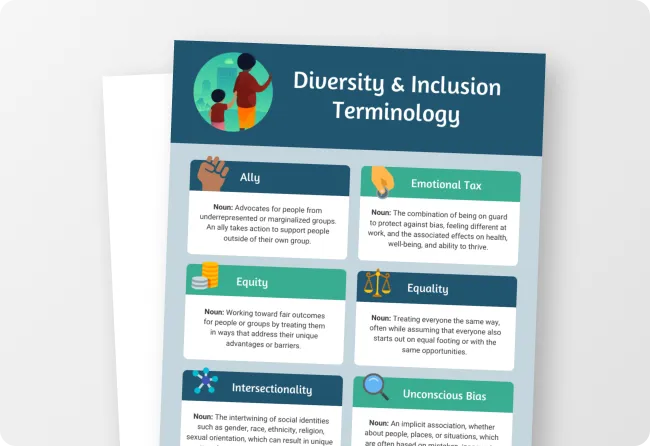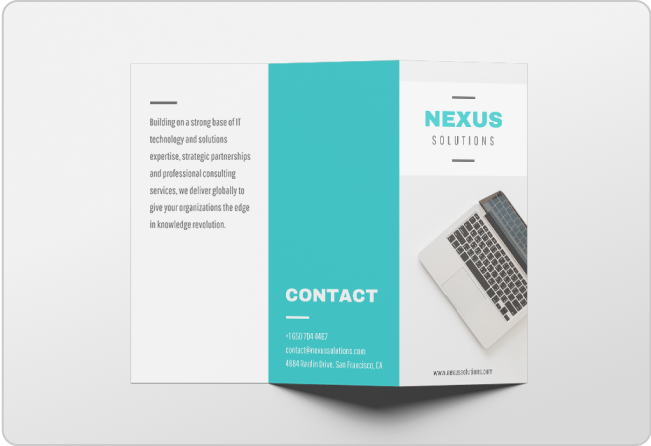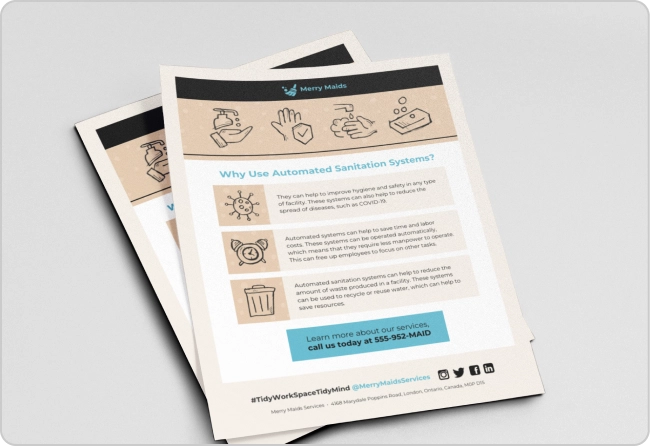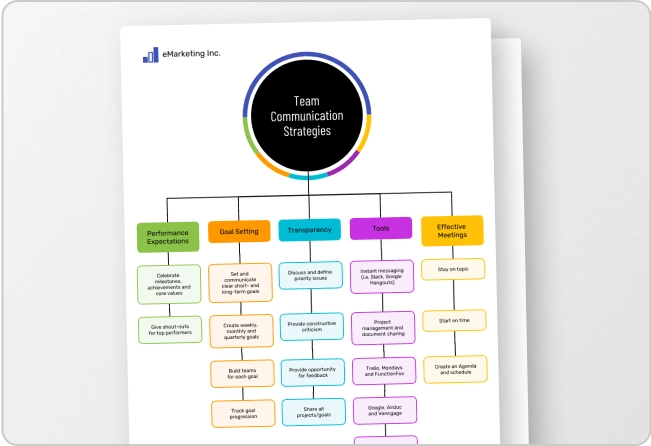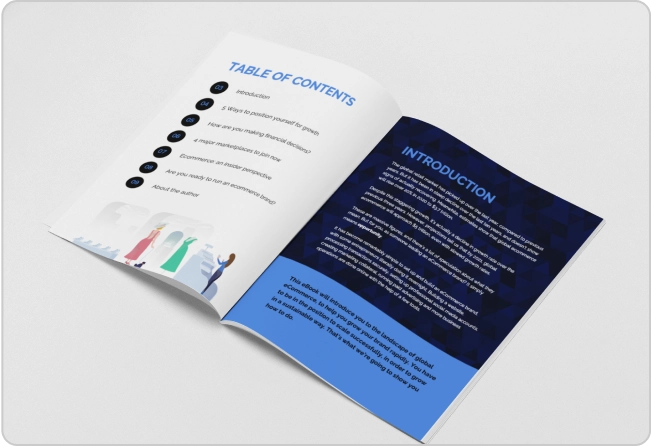
I first got introduced to Napkin AI by a colleague. And if I had to be honest, I was mind-blown. I pasted a 200-word draft in it and got clean diagrams in seconds.
It felt magical for the first few times, but the novelty faded fast. I realized I couldn’t tweak diagrams the way I wanted, team collaboration was missing and the visuals felt too generic.
Napkin AI is great at turning text into visuals, but it has limits. In this article, I’ll walk you through seven tried-and-tested alternatives so you can pick the one that fits your real needs.
7 best Napkin AI alternatives
After using it for the first few times, Napkin AI leaves you wanting for more control, better quality diagrams and better collaboration. That’s where the right tool makes a remarkable difference.
Here are seven tried-and-tested options that offer richer diagram templates, powerful editing capabilities and a range of pricing options you can choose from.

Venngage is an all-in-one design suite built for turning raw data and business content into polished reports, infographics and mind maps. It comes with an intuitive drag-and-drop editor, a huge library of diagram and mind map templates and tools to import data from spreadsheets or CSVs.
According to a MarketingMonk report, Venngage serves over 5 million professionals globally.
Pro-tip: If you’re looking at other design tools too, this Canva alternatives guide shows how Venngage gives you more flexibility for business visuals.
Compared to Napkin AI, Venngage is more focused on report design and data visualization. That’s to say, Venngage isn’t just limited to mind-mapping or diagramming.
Pros:
- Library with over 10,000 templates
- Imports data from spreadsheets or CSVs to build charts and tables
- My Brand Kit feature to maintain brand consistency
- Powerful collaboration features and multiple export formats
Cons:
- Some advanced features require paid subscription
- Limited offline functionality
Best for: Marketing teams, educators, nonprofits and small businesses that need branded, data-driven visuals
Pricing: Free plan available; paid plan starts at $10/month
Venngage is a straightforward tool to make any form of design. People with almost nil experience can get started with this tool. The best part of Venngage is that it has thousands of customizable templates to get you started.
Sid V., Manager, from G2 reviews
2. Lucidchart: Best for technical and complex diagrams

Lucidchart is a well-known diagramming tool that helps users design flowcharts, mind maps, sequence diagrams, entity-relationship diagrams (ERDs) and complex system architecture with AI assistance.
It uses natural language AI to generate diagrams from text, integrates deeply with tools like ChatGPT and supports real-time collaboration.
Fueler notes that Lucidchart serves over 130 million users worldwide, including a large share of Fortune 500 companies.
Compared to Napkin AI, it’s far stronger when you need precise technical control and detailed, structured visuals.
Pros:
- AI-generated diagrams from text prompts
- Collaboration-friendly with revision history and team commenting
- Integrations with Google Workspace, Jira, Microsoft 365, Confluence and ChatGPT
Cons:
- Steep learning curve due to its extensive range of features
- More advanced collaboration features require a higher subscription plan
Best for: Professional or academic teams that frequently need to create professional diagrams and visualize complex systems
Pricing: Free plan available; paid plans start at $9/month/user
I love the diagramming tool; it has been so helpful in my work in trying to identify existing processes to see where things can be improved. It’s also been such a game changer when our team is putting together documentation around reports and data structure.
Katherine T., Business Systems Analyst, from G2 reviews
3. Miro: Best for collaboration-friendly work

Miro is a digital whiteboard platform with AI-powered visual generation that helps teams brainstorm, diagram and plan together in real time.
It provides an “infinite canvas” where you can drop charts, sticky notes, images and AI-synthesized content.
Miro’s official disclosures show that it has crossed 100 million users, with more than 250,000 organizations using it worldwide.
Unlike Napkin AI, Miro is built for remote team collaboration, brainstorming and cross-functional ideation sessions.
Pros:
- Real-time collaboration with distributed teams working on the same board
- AI-generated diagrams and summaries to speed up ideation
- Vast template library for everything from strategic roadmaps to retrospective boards
- Integrates with more than 160 tools
Cons:
- Steep learning curve for users not familiar with whiteboarding tools
- Limited offline functionality
Best For: Creative teams, product teams and agile project groups who need a reliable whiteboard space for brainstorming and planning
Pricing: Free plan available; Starter plan from $8/user/month
I recently used Miro to plan a marketing campaign and was impressed with how easy it was to organize ideas visually. The templates are super helpful, and the real-time collaboration worked really well. The free plan is a little limited, and it takes a bit to learn, but overall it’s a great tool for marketers who like to brainstorm and map things out.
u/MotorCollection9604, from a sub-reddit discussion
4. Gamma AI: Best for quick mind maps and outlines
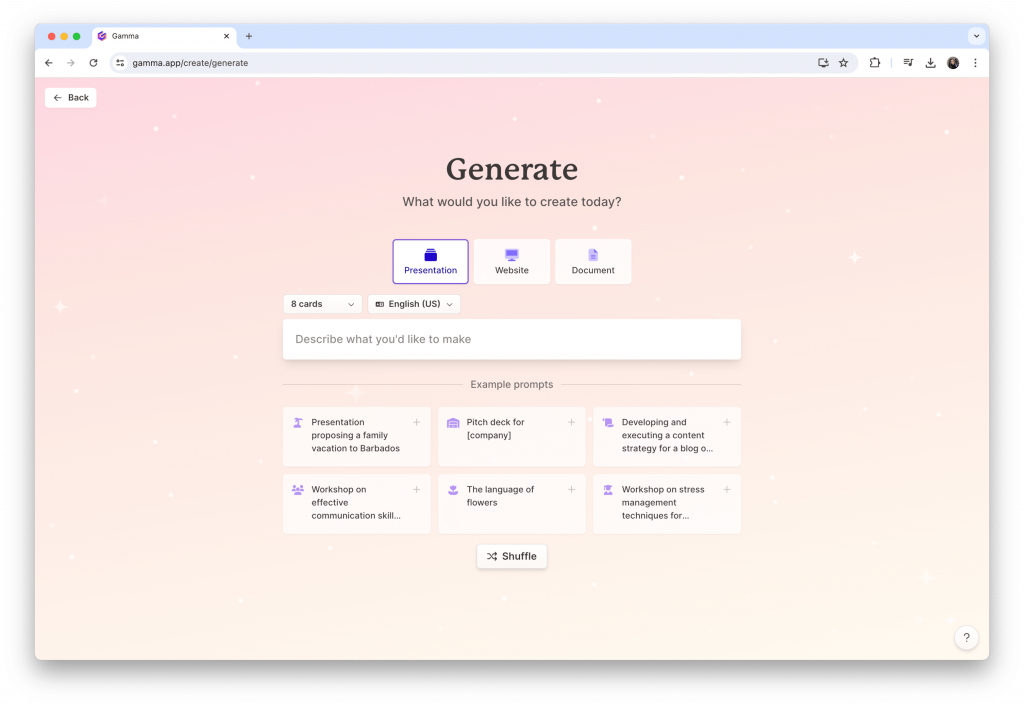
Gamma AI turns your ideas or long-form text into a complete, elegant presentation in minutes.
Instead of piecemeal diagrams like Napkin AI, Gamma builds a full deck with responsive design, card-based layouts and clean themes. It’s built to handle everything from pitch decks and reports to websites or scrollable documents.
Pros:
- Turns plain text or uploaded documents into polished presentations
- Card-based editor makes its easy for users to rearrange and reuse content
- Collaboration tools let you co-edit in real time with team comments
Cons:
- Doesn’t support offline editing
- Templates can feel repetitive after you generate multiple decks
Best for: Students, educators, startups and professionals who need visually appealing presentations, website mockups and documents without extensive design experience
Pricing: Free plan available; paid subscription starts at $10/month/user
Gamma AI helps me create attractive presentations and carousels for my university and company efficiently. You can drag and drop content or write your content, and the AI will automatically generate presentations with AI images quickly and easily. The AI-generated images need to be more professional.
Nihal S., e-learning founder, from G2 reviews
5. EdrawMax: Best for creating customizable diagrams
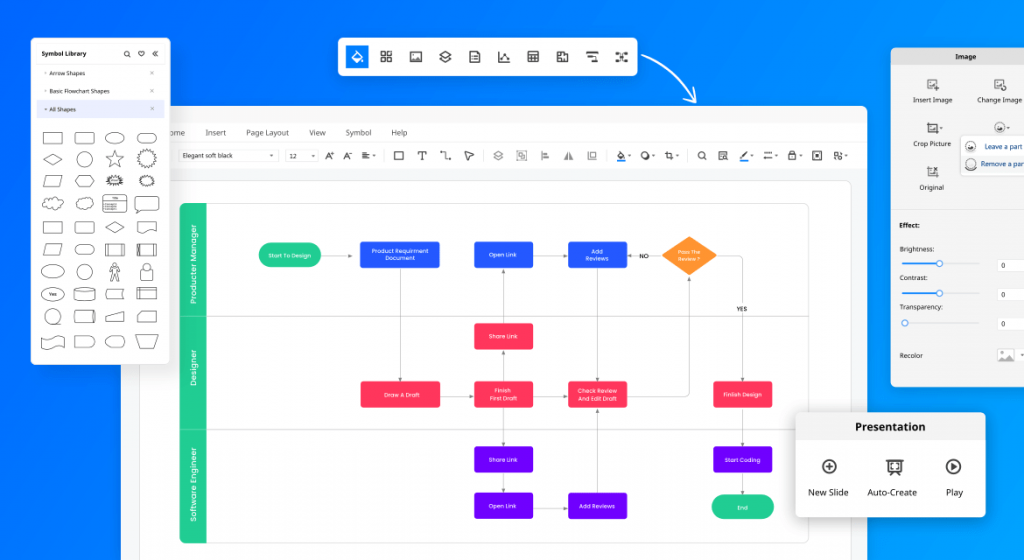
EdrawMax is a powerful diagramming tool that supports over 210 diagram types, from flowcharts and ERDs to Gantt charts and network diagrams. EdrawMax also comes equipped with AI-assisted layout and text-to-diagram conversion.
The tool also provides cloud storage and lets you import/export to Visio, PowerPoint, Word, PDF and more.
Compared to Napkin AI, EdrawMax gives you vastly broader diagramming capabilities and file interoperability.
Pros:
- Supports 210+ types of diagrams including charts, UML, mind maps, etc.
- Edraw AI turns text prompts into diagrams or refine layouts
- Real-time collaboration features and storage on EdrawMax Cloud
Cons:
- You must pay extra ($15.9/month; non-refundable) for tokens to use the AI features
- Limited template choices compared to most tools in this list
Best for: Professionals, students and designers who regularly need to create diagrams, flowcharts and other visual documents
Pricing: Free plan not available; plans start at $59.99/year
Been using it for my diagrams for networks and processes. This helps me with my daily thinking! and a great alternative to other software since it is flexible and can be used on mobile!
Cristian Paul Balunan, from Trustpilot reviews
6. MyMap.ai: Best for effortless mind map creation
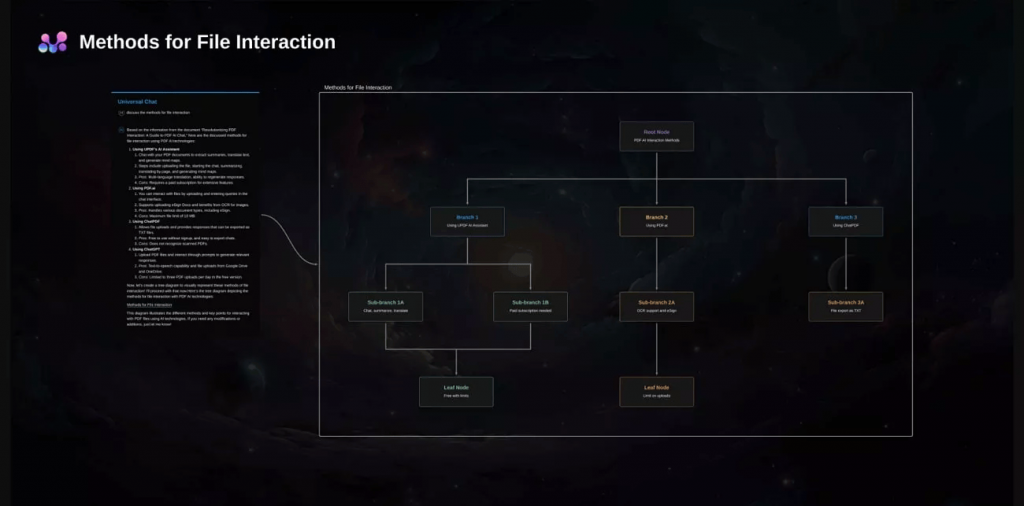
MyMap.ai is an AI-based visual thinking tool that turns text, URLs or uploaded files into interactive 2D mind maps. It also supports real-time collaboration and lets you export maps as PNG or PDF.
MyMap.ai also lets its users summarize videos, PDFs and articles, then turn them into mind maps and flashcards for better knowledge retention.
Pros:
- Converts text, files, or URLs into AI-generated mind maps
- Pulls live web data to make sure maps reflect the latest information
- Summarizer tool that also creates mind maps or flowcharts
- Great for collaborative teams to build or edit maps together in real time
Cons:
- limited customization and manual control
- Poor export options
Best for: Researchers, students and professional teams who want to build maps collaboratively
Pricing: Pricing information not available on its website; according to Techjockey, it costs $20/month
MyMap is a genuinely innovative tool that largely delivers on its core promise of fast, effortless, AI-powered diagramming. Its ability to transform text, documents, and web pages into clear visuals is impressive and points toward the future of productivity software.
However, its strength—simplicity—is also its weakness, leading to limited manual control and customization that power users will miss. More importantly, the recurring and serious user complaints regarding billing and customer support are impossible to ignore and represent a substantial risk for any potential subscriber.
From the Skywork blog
7. ContextMinds: Best for research mapping
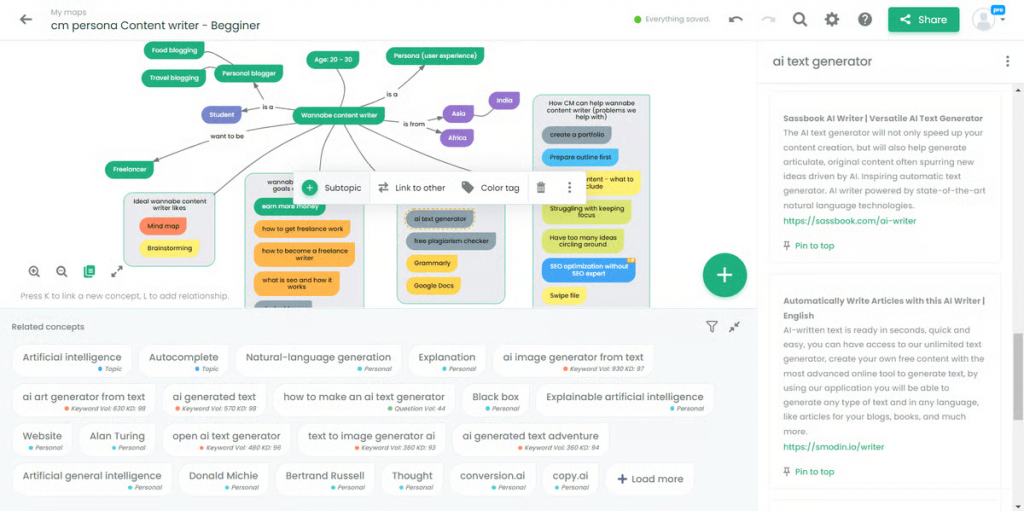
ContextMinds is a visual context‑charting tool that uses AI to help you brainstorm, research and organize complex ideas.
It gives you a whiteboard where users can drop in topics, AI‑suggested related concepts, web search results and notes. Then, they can use the map as a live GPT prompt to generate summaries, outlines or drafts.
Unlike Napkin AI, ContextMinds acts more like a research assistant and ideation hub, rather than just a visualizer.
Pros:
- Uses AI to automatically suggest related topics, keywords and web articles
- Let users structure research visually and use that map to generate maps
- User-friendly drag‑and‑drop whiteboard for rearranging ideas easily
Cons:
- Comes with a steep learning curve, especially for beginners
- Limited export options
Best for: Content creators, researchers or deep work professionals who need to map ideas and research before writing
Pricing: No free plan; plans start at $8/month
ContextMinds is definitely one of my best purchases so far. It’s helping me to organize topics, outline blog posts, and outline my content strategy. Although the AI-generated text is quite awful, I don’t rely on it for my content needs. The flexibility to freely move around topics and link them to other topics is also a great feature.
Trishan Mehta, from AppSumo reviews
What to look for in an AI visualization tool
Choosing the right AI visualization tool means matching it to how you actually think, organize and present.
You shouldn’t be picking a tool just because its UI looks pretty or it’s priced more reasonably than others. You also need to consider what matters for your workflow.
1. Speed and ease of use
The best tools let you turn ideas or text into visuals in seconds, even if you’re not a designer.
Look for natural language prompting so you can write out your thoughts clearly and generate visuals that align with your needs.
The AI should handle the heavy lifting for alignment, spacing and structure. As a rule of thumb, go with tools that offer intuitive UI so that anyone on your team can contribute.
2. Variety of outputs
Doesn’t settle with a tool that supports only one type (say, flowcharts) of diagram. That’s because you might risk hitting limits when your needs evolve down the road.
Go with a tool that offers a broader range of outputs. The more formats, the more use cases you cover (and more bang for your buck).
For instance, Venngage offers hundreds of diagram types, such as mind maps, flowcharts, timelines, concept maps, decision trees and org charts. This gives you room to grow and maximize your return on investment.
You can also explore Venngage’s AI Infographic Generator if you want to turn complex ideas into clean, presentation-ready visuals with almost zero manual design work.
With Venngage, you can even use AI to create the first draft and make manual edits later to ensure brand alignment. Here’s an example of a map that I created with Venngage’s AI Concept Map Generator with the prompt below:
“Create a concept map that explains how to build healthy daily habits, covering triggers, routines, rewards, examples, and tips for consistency, organized in a clear hierarchical flow.”
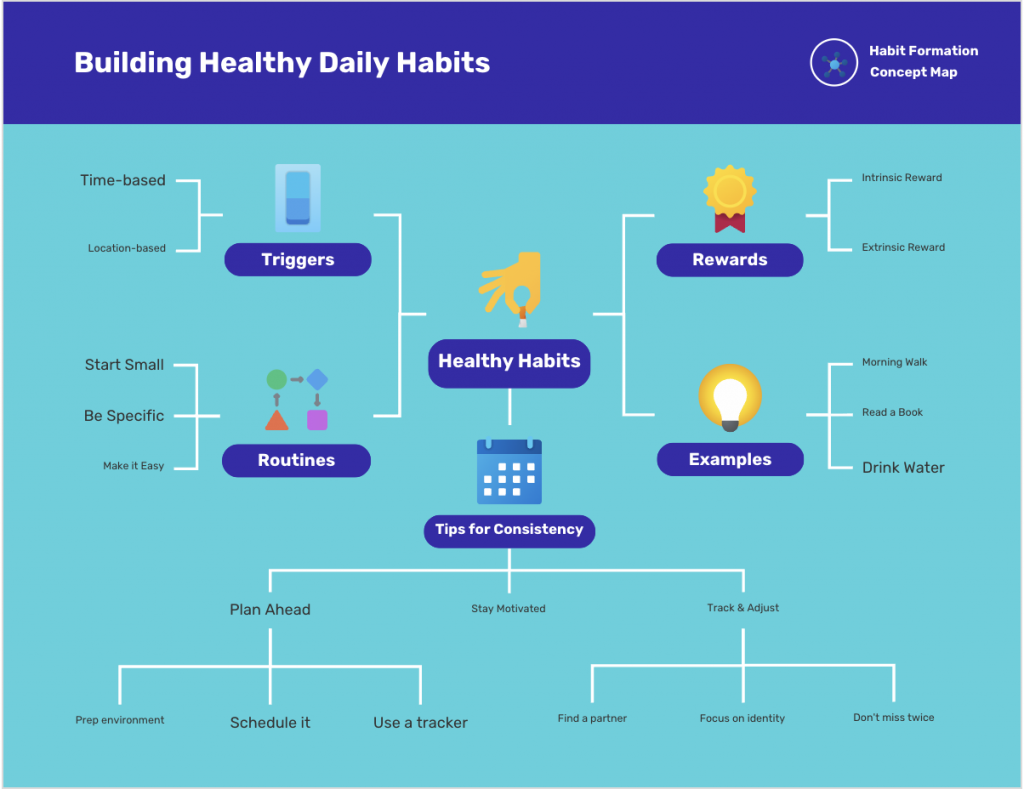
3. Collaboration features
Collaboration features matter if you’re used to working in a growing team. You’ll want a tool that lets everyone contribute, edit together and shape ideas in real time.
Look for key features like commenting and version history so that you can speed up the design process and track feedback.
Shared workspaces also make it easier for teams to revisit drafts without losing context. And if the tool connects with what you already use, like Slack or Google Workspace, you’ll spend less time switching tabs and more time building better diagrams.
4. Integration and export
The tool you’ll choose should let you export your work in common formats, whether you need a PowerPoint deck, a polished PDF or a simple HTML embed.
It also helps to have a tool that comes with key integrations with related tools such as Figma, Google Slides or similar other platforms.
If your diagrams rely on live or structured data, make sure it can pull in spreadsheets and interpret that information directly into your visuals.
5. Customization and branding
Pick a tool that lets you apply your branding consistently, with customizable colors, fonts and logos. This way, you can make your visuals always feel unique.
A strong template library helps you get started fast, but you should also be able to adjust layouts and designs as per your requirements. Look for smart layout features that let you refine AI-generated diagrams manually but quickly, without having to rebuild everything from scratch.
6. Pricing and free plans
We strongly recommend that you go with a tool that offers a generous free trial or has a free tier. A good free plan or trial lets you explore the AI and see if the interface fits your workflow before committing long-term.
Pay attention to pricing tiers; some tools charge by credits or tokens, while others use flat monthly fees.
Also watch for extra costs, like storage limits, premium exports, advanced AI features or team collaboration, which can quickly add up.
How to choose the right alternative
Choosing the right alternative to Napkin AI starts with understanding how you work and what you need to produce.
1. Understand your use case
Are you a solo professional who needs to draft quick diagrams, a marketing professional who wants to create on-brand infographics or part of a research team that needs detailed presentations?
Your use case should guide your buying decision.
2. Solo vs team requirements
If you work alone, prioritize tools with simple, intuitive interfaces that allows you to generate diagrams or reports quickly without extensive setup.
Venngage, for example, provides hundreds of templates for infographics, reports, and presentations.
Team-based workflows demand collaboration features. Tools like Miro or Gamma allow multiple users to co-edit in real time, leave comments or track version history.
3. Match tool complexity to your visual needs
You must also consider the complexity of the visuals you need. Mind-mapping and flowcharts suit brainstorming and planning, while data-heavy reports, timelines, and full slide decks demand tools that can import spreadsheets, automatically generate charts, and maintain a professional layout.
As an example, EdrawMax offers 210 diagram types and imports from Visio, PowerPoint, Word, and CSV.
4. Ease of adoption
Ease of adoption is critical but also understated. Tools with intuitive drag-and-drop interfaces, smart auto-layout, or AI-assisted suggestions minimize onboarding time.
If your team is new to AI-assisted visualization, pick platforms that offer guided tutorials, in-app product tours or responsive customer support.
5. Output quality
Output quality is another differentiator. Some AI tools (like Napkin AI) generate basic diagrams suitable for general use cases. Other tools produce polished, client-ready visuals. Venngage and Gamma excel at this.
6. Pricing and trial options
Pricing can also influence choice. Many tools offer tiered plans, token-based usage, or monthly subscriptions. Look for platforms that provide free access or trials so you can test AI performance, template variety and collaboration features before making a financial commitment.
There are better ways to visualize your ideas
Napkin AI is impressive, but its limits in editing, polish and collaboration become clear once your projects grow.
The right tool should grow with your team’s needs, ideas and your workflow. If you want better control, professional and ready-to-publish templates and smooth collaboration, Venngage gives you all three. Try Venngage’s diagramming tool and see how much further your visuals can go.




























